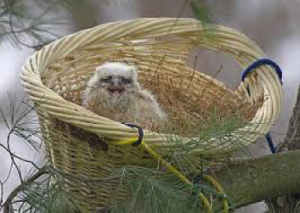Surrogate Bird Nest
Birds lack a strong sense of smell and the adult birds will not abandon its babies because of human scent on it. If you can find the original nest, put the baby bird back in that nest. If the nest is not intact or you are unable to find it, the next best thing to do is make a substitute nest and put it as close to where you think the original nest was. A good substitute can be made with a plastic margarine or Cool Whip container with small holes poked in the bottom for drainage. Line the container with lint from the dryer or dried grasses. This nest can be nailed to the side of the house or tree or secured to a bush or tree with twist ties, wire or duct tape. Do not feed the nestling, as its parents will respond to its squawking and return to feed it. Learn more about surrogate nests.
If you notice that the baby bird is bleeding, weak or shivering, wings drooping unevenly, or appears to have been attacked by a cat or dog, then the bird requires care. Place it in a cardboard box or paper bag and keep it warm, dark, and quiet. Do not give it food or water. Please call Tufts Wildlife Clinic for assistance, or if you have any questions. If it is after business hours, please leave a message, follow instructions on how to house the animal safely overnight, and bring the animal to the clinic in the morning.
To transport, you can create a surrogate bird nest. To make a replacement nest, take something like a cardboard box, basket, Cool Whip container, or Tupperware container and line it with grasses, torn up paper towels, newspaper, or the original nest material. Add a heat source such as a hot water bottle wrapped in a towel if possible. Place the nest and heat source into a container with air holes and keep the car quiet (radio off) during transport.
